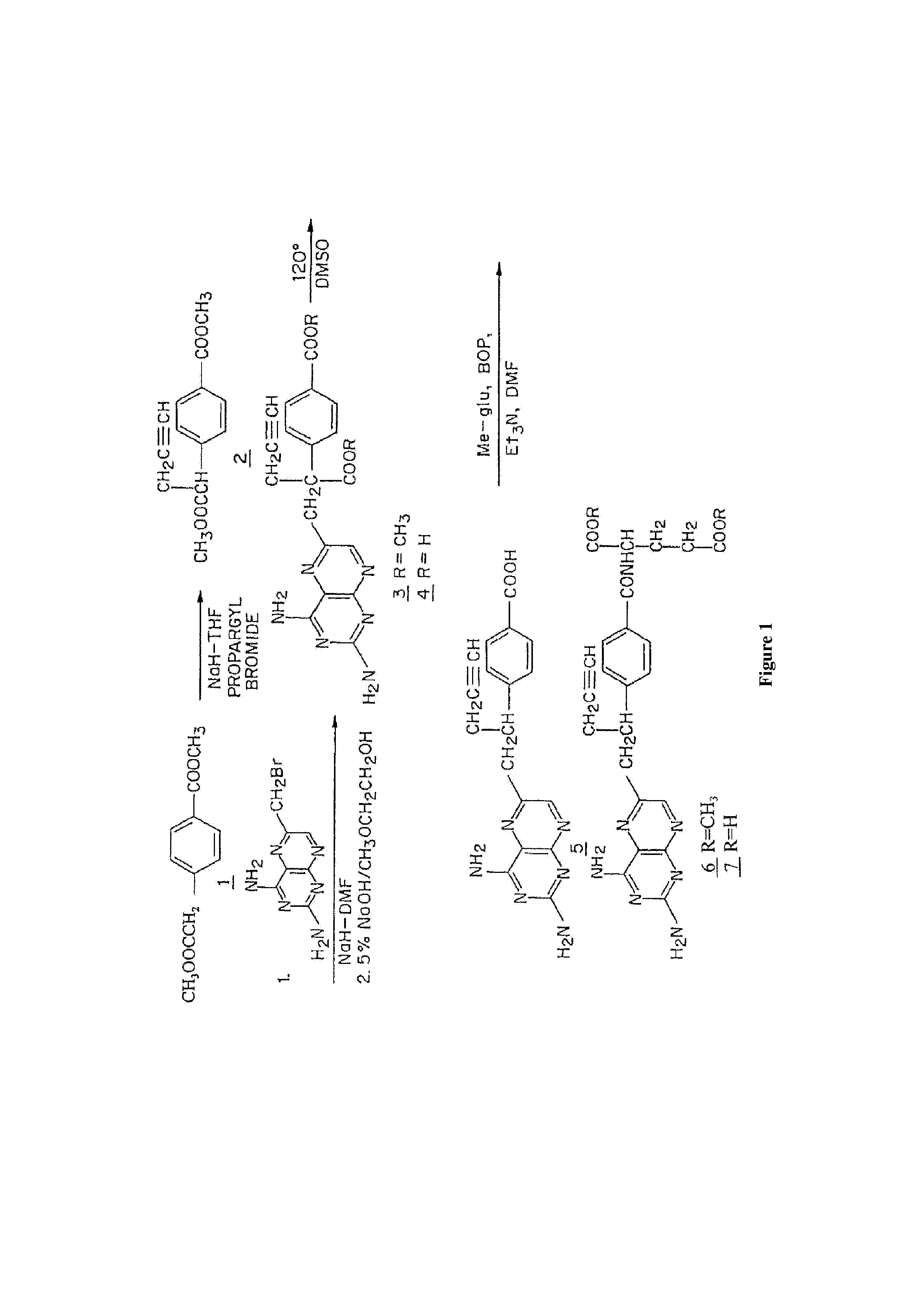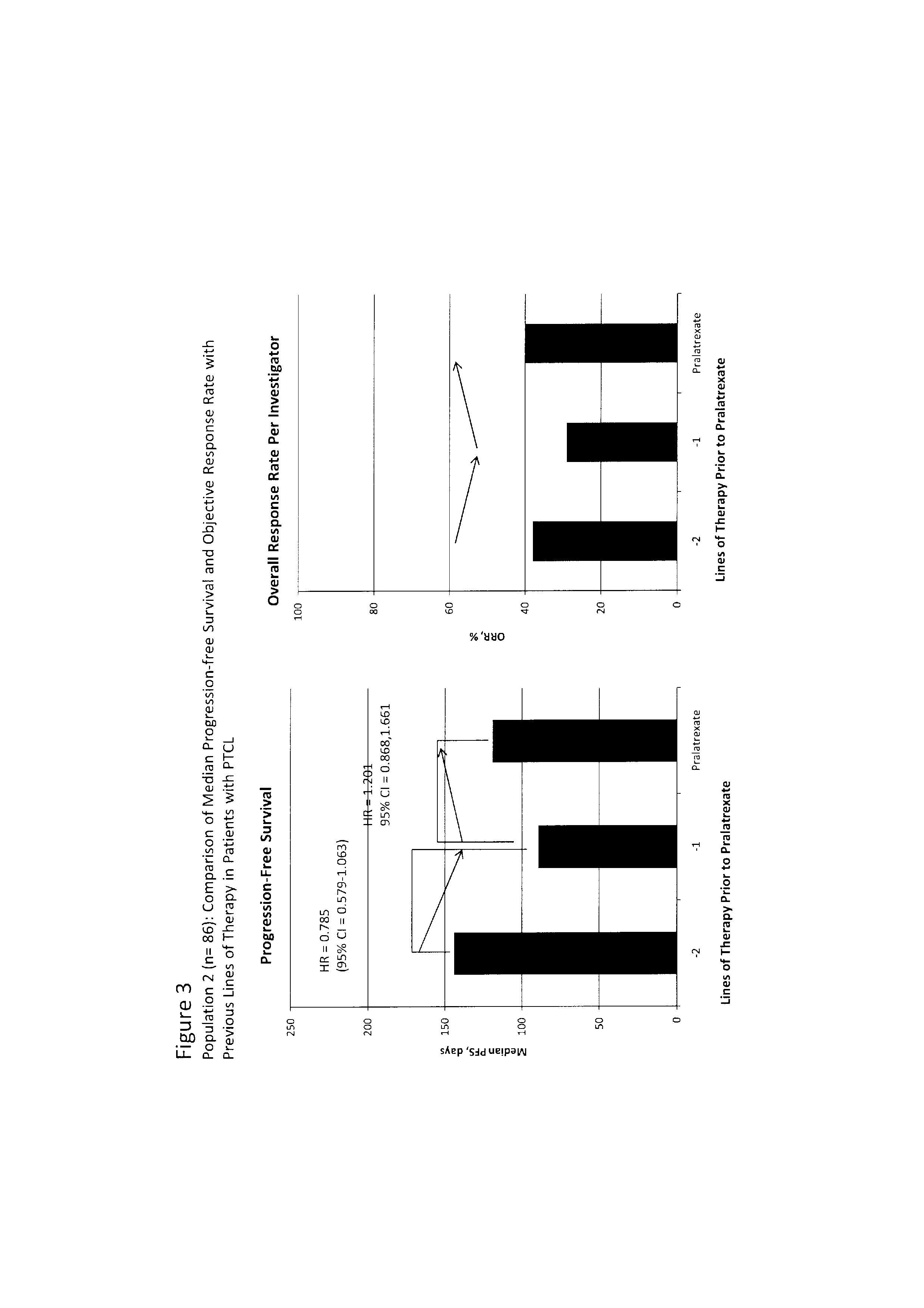Methods for Extending Progression-Free Survival using 10-Propargyl-10-Deazaaminopterin
- Summary
- Abstract
- Description
- Claims
- Application Information
AI Technical Summary
Benefits of technology
Problems solved by technology
Method used
Image
Examples
example 1
[0058]FIG. 1 shows a synthetic scheme useful in preparing 10-propargyl-10-deazaminopterin. A mixture of 60% NaH in oil dispersion (1.06 g, 26.5 mmol) in 18 mL of sieve-dried THF was cooled to 0° C. The cold mixture was treated with a solution of homoterephthalic acid dimethyl ester (5.0 g, 24 mmol compound 1 in FIG. 1) in dry THF (7 mL), and the mixture was stirred for 1 hour at 0° C. Propargyl bromide (26.4 mmol) was added, and the mixture was stirred at 0° C. for an additional 1 hour, and then at room temperature for 16 hours. The resulting mixture was treated with 2.4 mL of 50% acetic acid and then poured into 240 mL of water. The mixture was extracted with ether (2×150 mL). The ether extracts were combined, dried over Na2SO4, and concentrated to an orange-yellow oil. Chromatography on silica gel (600 mL of 230-400 mesh) with elution by cyclohexane-EtOAc (8:1) gave the product α-propargylhomoterephthalic acid dimethyl ester (compound 2) as a white solid (4.66) which appeared by T...
example 2
[0065]Analysis of progressive resistance. The treatment immediately prior to entry into clinical trial PDX-008 provides data from a heterogeneous control group reflecting clinical practice with which to compare the efficacy of pralatrexate. This dataset has the benefit of being from the same patients as those receiving pralatrexate, and so avoids inter-subject variation.
[0066]In a wide range of malignancies, including non-Hodgkin's lymphoma (NHL), treatment-naïve patients generally show a greater response to chemotherapy than patients receiving second-line or subsequent therapy. Furthermore, objective response rate (ORR) and progression-free survival (PFS) generally decrease with each subsequent line of therapy, the hallmark of acquired drug resistance. This trend would also be expected for PTCL, although there are no published studies or retrospective data analyses specifically in PTCL describing the pattern of response to successive treatments. The goal of the analysis presented h...
example 3
Pralatrexate is Effective in Patients with Relapsed / Refractory Peripheral T-cell Lymphoma (PTCL) Following Treatment with Ifosfamide, Carboplatin, and Etoposide (ICE)-BASED REGIMENS
[0093]Background:
[0094]The prognosis of aggressive PTCL is dismal. Investigators have developed salvage regimens attempting to improve outcomes for patients with relapsed or refractory disease. One such regimen frequently used is ifosfamide, carboplatin, and etoposide (ICE) or ICE-based regimens (eg, and rituximab-ICE [RICE] and dexamethasome-ICE [DICE]). These regimens can have response rates approaching 70% and patients may proceed to a stem cell transplant, yet most patients tend to relapse quickly (Horwitz et al Blood 2005; 106:a2679). Thus, optimal approaches for patients with relapsed or refractory disease are needed, and agents based on a unique mechanism of action warrant study. This analysis was conducted to determine if pralatrexate offered a beneficial treatment option for patients after treatm...
PUM
| Property | Measurement | Unit |
|---|---|---|
| Time | aaaaa | aaaaa |
| Time | aaaaa | aaaaa |
| Fraction | aaaaa | aaaaa |
Abstract
Description
Claims
Application Information
 Login to view more
Login to view more - R&D Engineer
- R&D Manager
- IP Professional
- Industry Leading Data Capabilities
- Powerful AI technology
- Patent DNA Extraction
Browse by: Latest US Patents, China's latest patents, Technical Efficacy Thesaurus, Application Domain, Technology Topic.
© 2024 PatSnap. All rights reserved.Legal|Privacy policy|Modern Slavery Act Transparency Statement|Sitemap



